CAM103 - Scientific Paper Appraisal: Herbal Weight Loss Efficacy
VerifiedAdded on 2023/06/04
|6
|1881
|479
Report
AI Summary
This report critically appraises a scientific paper by Dixit, Kamath, Alluri, and Davis (2018) on the efficacy of a novel herbal formulation (L185008F) for weight loss in overweight adults. The study, a 16-week randomized, double-blind, placebo-controlled clinical trial, is evaluated for its research methodology, including the use of positivism, data collection methods, and statistical analysis. Strengths, such as primary data collection and quantitative analysis, are highlighted alongside weaknesses like the limited scope of side effect analysis and geographical constraints. The results, indicating significant weight loss and improved lipid profiles in the L185008F group, are discussed in relation to the study's conclusions, which suggest the herbal component is safe and effective for weight management when combined with calorie restriction and physical activity. The appraisal also addresses the need for further research to explore long-term effects and nutritional aspects.
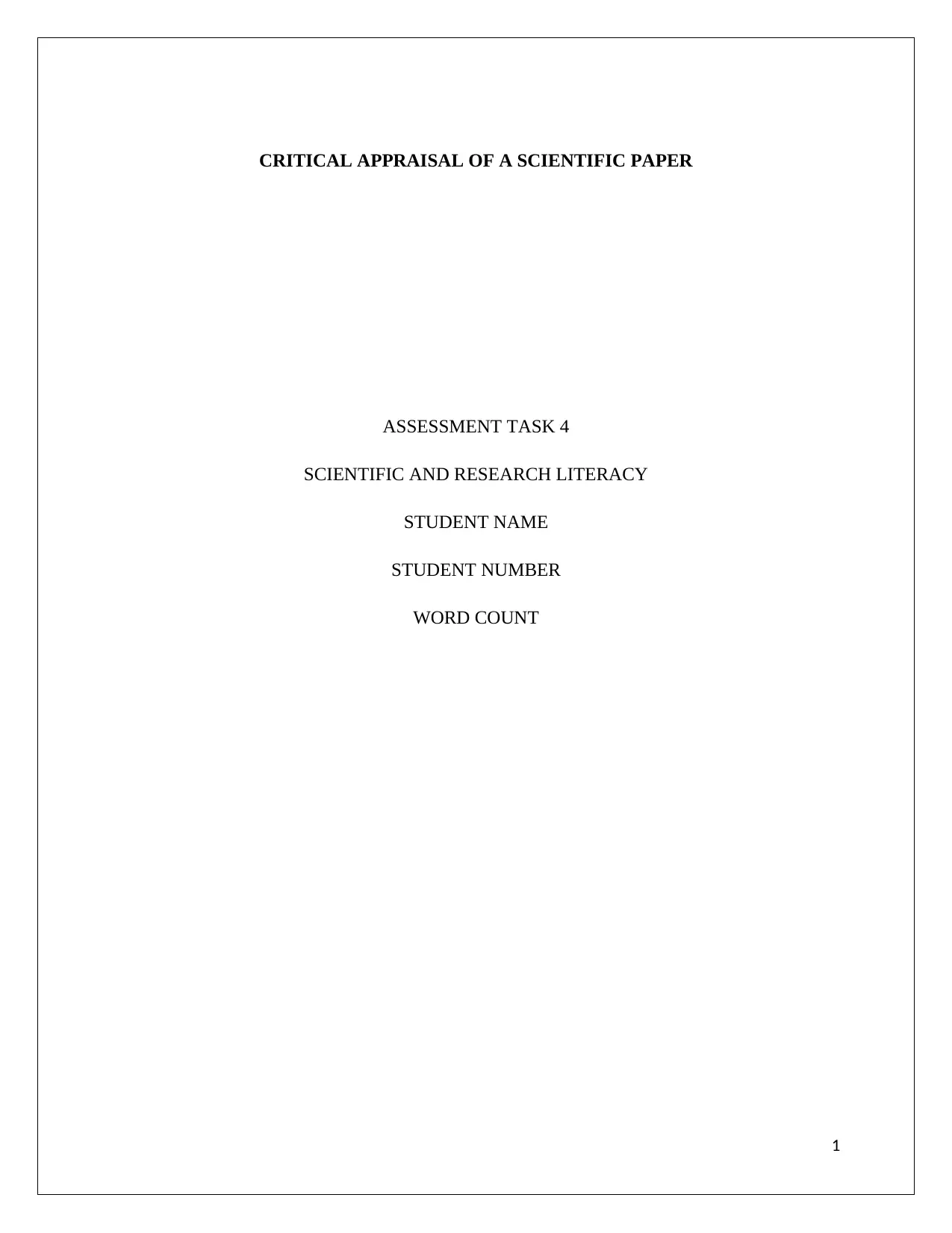
CRITICAL APPRAISAL OF A SCIENTIFIC PAPER
ASSESSMENT TASK 4
SCIENTIFIC AND RESEARCH LITERACY
STUDENT NAME
STUDENT NUMBER
WORD COUNT
1
ASSESSMENT TASK 4
SCIENTIFIC AND RESEARCH LITERACY
STUDENT NAME
STUDENT NUMBER
WORD COUNT
1
Paraphrase This Document
Need a fresh take? Get an instant paraphrase of this document with our AI Paraphraser
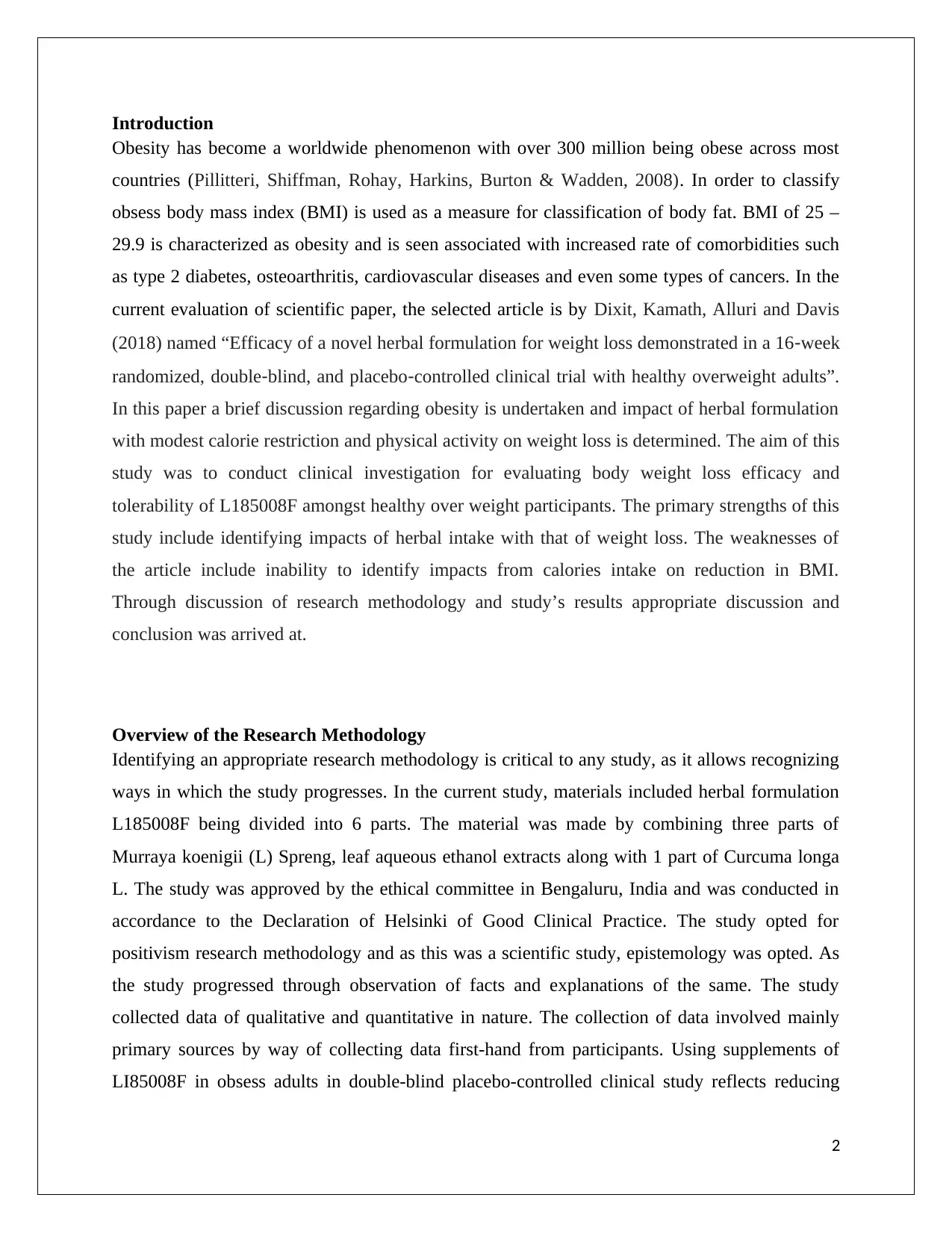
Introduction
Obesity has become a worldwide phenomenon with over 300 million being obese across most
countries (Pillitteri, Shiffman, Rohay, Harkins, Burton & Wadden, 2008). In order to classify
obsess body mass index (BMI) is used as a measure for classification of body fat. BMI of 25 –
29.9 is characterized as obesity and is seen associated with increased rate of comorbidities such
as type 2 diabetes, osteoarthritis, cardiovascular diseases and even some types of cancers. In the
current evaluation of scientific paper, the selected article is by Dixit, Kamath, Alluri and Davis
(2018) named “Efficacy of a novel herbal formulation for weight loss demonstrated in a 16‐week
randomized, double‐blind, and placebo‐controlled clinical trial with healthy overweight adults”.
In this paper a brief discussion regarding obesity is undertaken and impact of herbal formulation
with modest calorie restriction and physical activity on weight loss is determined. The aim of this
study was to conduct clinical investigation for evaluating body weight loss efficacy and
tolerability of L185008F amongst healthy over weight participants. The primary strengths of this
study include identifying impacts of herbal intake with that of weight loss. The weaknesses of
the article include inability to identify impacts from calories intake on reduction in BMI.
Through discussion of research methodology and study’s results appropriate discussion and
conclusion was arrived at.
Overview of the Research Methodology
Identifying an appropriate research methodology is critical to any study, as it allows recognizing
ways in which the study progresses. In the current study, materials included herbal formulation
L185008F being divided into 6 parts. The material was made by combining three parts of
Murraya koenigii (L) Spreng, leaf aqueous ethanol extracts along with 1 part of Curcuma longa
L. The study was approved by the ethical committee in Bengaluru, India and was conducted in
accordance to the Declaration of Helsinki of Good Clinical Practice. The study opted for
positivism research methodology and as this was a scientific study, epistemology was opted. As
the study progressed through observation of facts and explanations of the same. The study
collected data of qualitative and quantitative in nature. The collection of data involved mainly
primary sources by way of collecting data first-hand from participants. Using supplements of
LI85008F in obsess adults in double-blind placebo-controlled clinical study reflects reducing
2
Obesity has become a worldwide phenomenon with over 300 million being obese across most
countries (Pillitteri, Shiffman, Rohay, Harkins, Burton & Wadden, 2008). In order to classify
obsess body mass index (BMI) is used as a measure for classification of body fat. BMI of 25 –
29.9 is characterized as obesity and is seen associated with increased rate of comorbidities such
as type 2 diabetes, osteoarthritis, cardiovascular diseases and even some types of cancers. In the
current evaluation of scientific paper, the selected article is by Dixit, Kamath, Alluri and Davis
(2018) named “Efficacy of a novel herbal formulation for weight loss demonstrated in a 16‐week
randomized, double‐blind, and placebo‐controlled clinical trial with healthy overweight adults”.
In this paper a brief discussion regarding obesity is undertaken and impact of herbal formulation
with modest calorie restriction and physical activity on weight loss is determined. The aim of this
study was to conduct clinical investigation for evaluating body weight loss efficacy and
tolerability of L185008F amongst healthy over weight participants. The primary strengths of this
study include identifying impacts of herbal intake with that of weight loss. The weaknesses of
the article include inability to identify impacts from calories intake on reduction in BMI.
Through discussion of research methodology and study’s results appropriate discussion and
conclusion was arrived at.
Overview of the Research Methodology
Identifying an appropriate research methodology is critical to any study, as it allows recognizing
ways in which the study progresses. In the current study, materials included herbal formulation
L185008F being divided into 6 parts. The material was made by combining three parts of
Murraya koenigii (L) Spreng, leaf aqueous ethanol extracts along with 1 part of Curcuma longa
L. The study was approved by the ethical committee in Bengaluru, India and was conducted in
accordance to the Declaration of Helsinki of Good Clinical Practice. The study opted for
positivism research methodology and as this was a scientific study, epistemology was opted. As
the study progressed through observation of facts and explanations of the same. The study
collected data of qualitative and quantitative in nature. The collection of data involved mainly
primary sources by way of collecting data first-hand from participants. Using supplements of
LI85008F in obsess adults in double-blind placebo-controlled clinical study reflects reducing
2
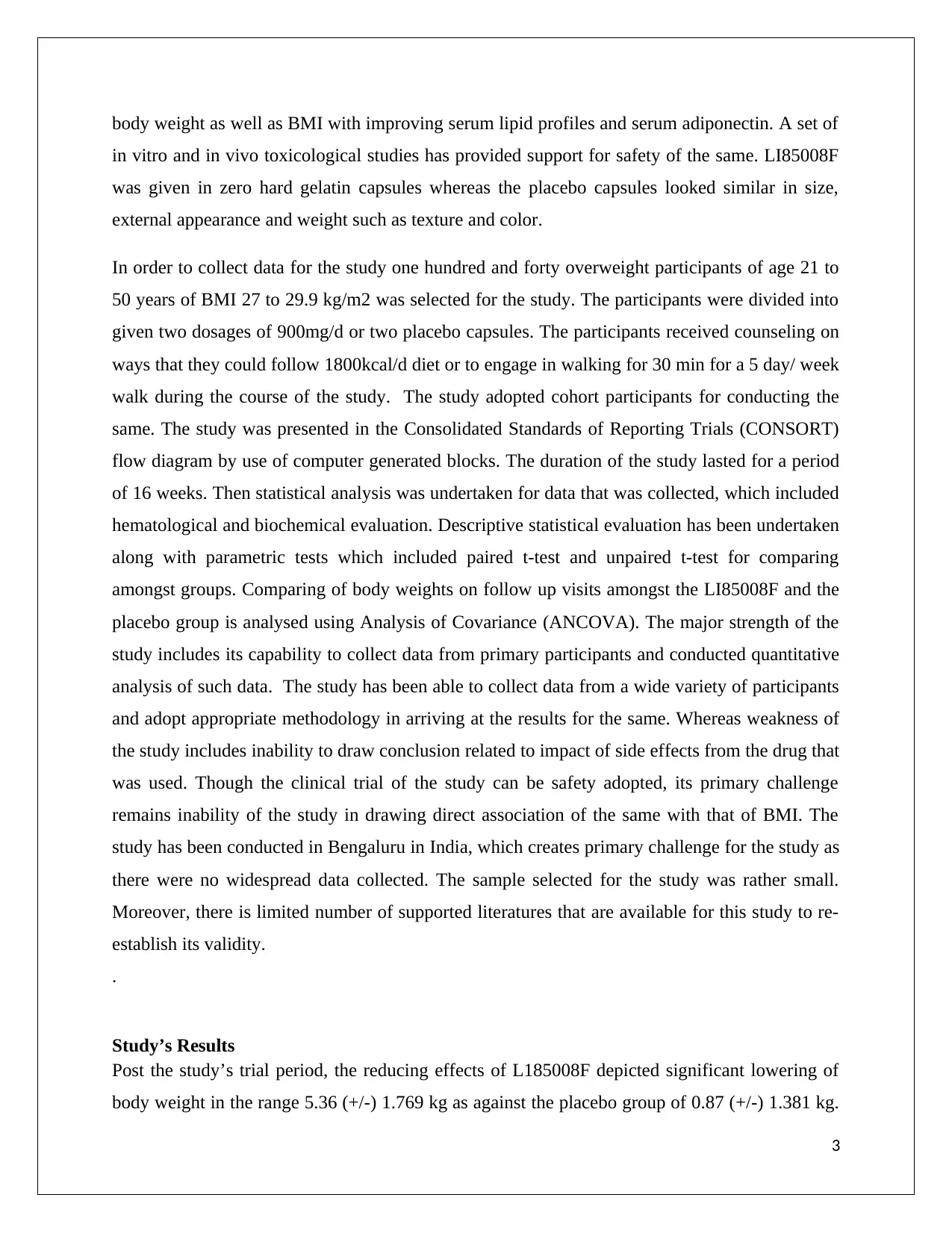
body weight as well as BMI with improving serum lipid profiles and serum adiponectin. A set of
in vitro and in vivo toxicological studies has provided support for safety of the same. LI85008F
was given in zero hard gelatin capsules whereas the placebo capsules looked similar in size,
external appearance and weight such as texture and color.
In order to collect data for the study one hundred and forty overweight participants of age 21 to
50 years of BMI 27 to 29.9 kg/m2 was selected for the study. The participants were divided into
given two dosages of 900mg/d or two placebo capsules. The participants received counseling on
ways that they could follow 1800kcal/d diet or to engage in walking for 30 min for a 5 day/ week
walk during the course of the study. The study adopted cohort participants for conducting the
same. The study was presented in the Consolidated Standards of Reporting Trials (CONSORT)
flow diagram by use of computer generated blocks. The duration of the study lasted for a period
of 16 weeks. Then statistical analysis was undertaken for data that was collected, which included
hematological and biochemical evaluation. Descriptive statistical evaluation has been undertaken
along with parametric tests which included paired t-test and unpaired t-test for comparing
amongst groups. Comparing of body weights on follow up visits amongst the LI85008F and the
placebo group is analysed using Analysis of Covariance (ANCOVA). The major strength of the
study includes its capability to collect data from primary participants and conducted quantitative
analysis of such data. The study has been able to collect data from a wide variety of participants
and adopt appropriate methodology in arriving at the results for the same. Whereas weakness of
the study includes inability to draw conclusion related to impact of side effects from the drug that
was used. Though the clinical trial of the study can be safety adopted, its primary challenge
remains inability of the study in drawing direct association of the same with that of BMI. The
study has been conducted in Bengaluru in India, which creates primary challenge for the study as
there were no widespread data collected. The sample selected for the study was rather small.
Moreover, there is limited number of supported literatures that are available for this study to re-
establish its validity.
.
Study’s Results
Post the study’s trial period, the reducing effects of L185008F depicted significant lowering of
body weight in the range 5.36 (+/-) 1.769 kg as against the placebo group of 0.87 (+/-) 1.381 kg.
3
in vitro and in vivo toxicological studies has provided support for safety of the same. LI85008F
was given in zero hard gelatin capsules whereas the placebo capsules looked similar in size,
external appearance and weight such as texture and color.
In order to collect data for the study one hundred and forty overweight participants of age 21 to
50 years of BMI 27 to 29.9 kg/m2 was selected for the study. The participants were divided into
given two dosages of 900mg/d or two placebo capsules. The participants received counseling on
ways that they could follow 1800kcal/d diet or to engage in walking for 30 min for a 5 day/ week
walk during the course of the study. The study adopted cohort participants for conducting the
same. The study was presented in the Consolidated Standards of Reporting Trials (CONSORT)
flow diagram by use of computer generated blocks. The duration of the study lasted for a period
of 16 weeks. Then statistical analysis was undertaken for data that was collected, which included
hematological and biochemical evaluation. Descriptive statistical evaluation has been undertaken
along with parametric tests which included paired t-test and unpaired t-test for comparing
amongst groups. Comparing of body weights on follow up visits amongst the LI85008F and the
placebo group is analysed using Analysis of Covariance (ANCOVA). The major strength of the
study includes its capability to collect data from primary participants and conducted quantitative
analysis of such data. The study has been able to collect data from a wide variety of participants
and adopt appropriate methodology in arriving at the results for the same. Whereas weakness of
the study includes inability to draw conclusion related to impact of side effects from the drug that
was used. Though the clinical trial of the study can be safety adopted, its primary challenge
remains inability of the study in drawing direct association of the same with that of BMI. The
study has been conducted in Bengaluru in India, which creates primary challenge for the study as
there were no widespread data collected. The sample selected for the study was rather small.
Moreover, there is limited number of supported literatures that are available for this study to re-
establish its validity.
.
Study’s Results
Post the study’s trial period, the reducing effects of L185008F depicted significant lowering of
body weight in the range 5.36 (+/-) 1.769 kg as against the placebo group of 0.87 (+/-) 1.381 kg.
3
⊘ This is a preview!⊘
Do you want full access?
Subscribe today to unlock all pages.

Trusted by 1+ million students worldwide
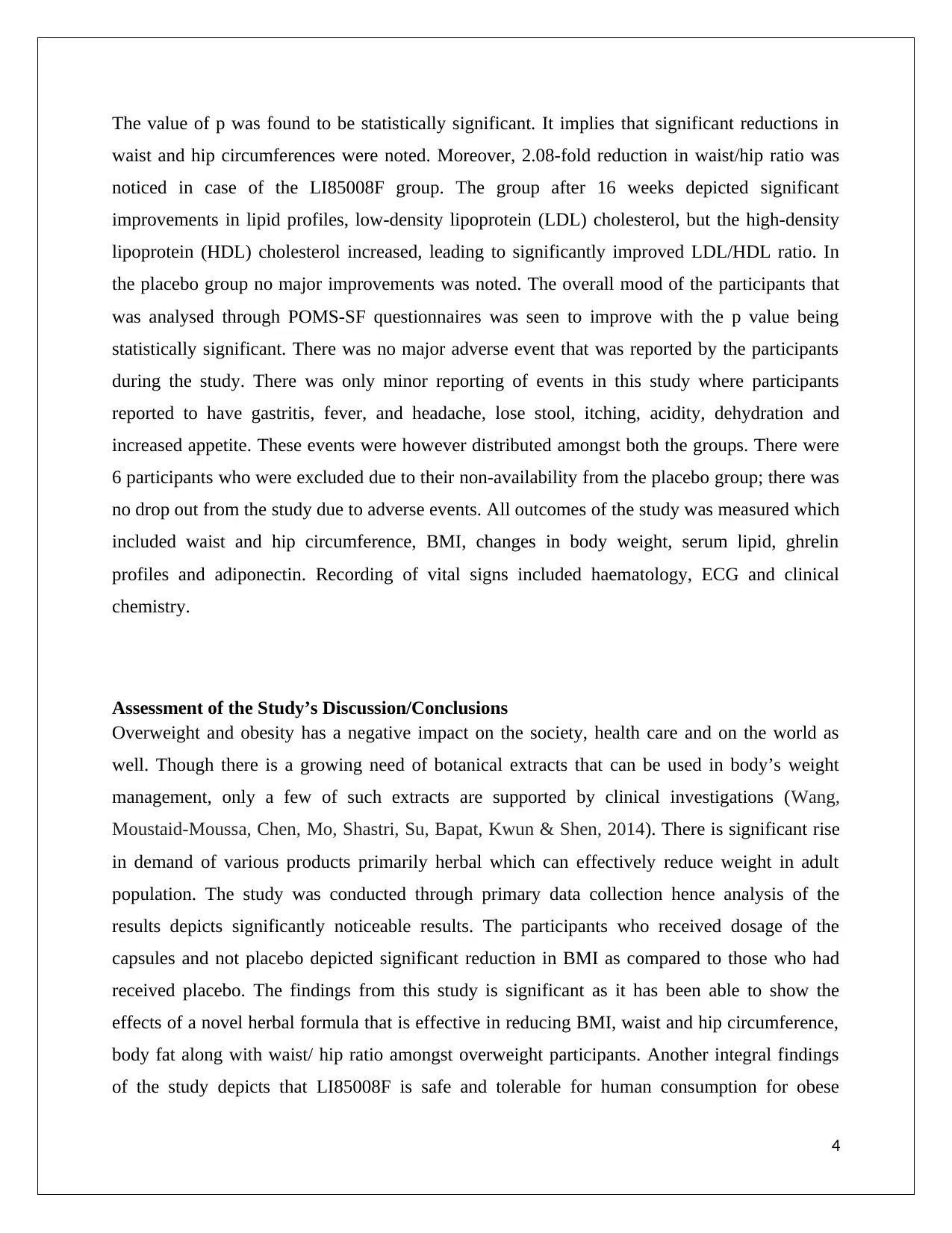
The value of p was found to be statistically significant. It implies that significant reductions in
waist and hip circumferences were noted. Moreover, 2.08-fold reduction in waist/hip ratio was
noticed in case of the LI85008F group. The group after 16 weeks depicted significant
improvements in lipid profiles, low-density lipoprotein (LDL) cholesterol, but the high-density
lipoprotein (HDL) cholesterol increased, leading to significantly improved LDL/HDL ratio. In
the placebo group no major improvements was noted. The overall mood of the participants that
was analysed through POMS-SF questionnaires was seen to improve with the p value being
statistically significant. There was no major adverse event that was reported by the participants
during the study. There was only minor reporting of events in this study where participants
reported to have gastritis, fever, and headache, lose stool, itching, acidity, dehydration and
increased appetite. These events were however distributed amongst both the groups. There were
6 participants who were excluded due to their non-availability from the placebo group; there was
no drop out from the study due to adverse events. All outcomes of the study was measured which
included waist and hip circumference, BMI, changes in body weight, serum lipid, ghrelin
profiles and adiponectin. Recording of vital signs included haematology, ECG and clinical
chemistry.
Assessment of the Study’s Discussion/Conclusions
Overweight and obesity has a negative impact on the society, health care and on the world as
well. Though there is a growing need of botanical extracts that can be used in body’s weight
management, only a few of such extracts are supported by clinical investigations (Wang,
Moustaid-Moussa, Chen, Mo, Shastri, Su, Bapat, Kwun & Shen, 2014). There is significant rise
in demand of various products primarily herbal which can effectively reduce weight in adult
population. The study was conducted through primary data collection hence analysis of the
results depicts significantly noticeable results. The participants who received dosage of the
capsules and not placebo depicted significant reduction in BMI as compared to those who had
received placebo. The findings from this study is significant as it has been able to show the
effects of a novel herbal formula that is effective in reducing BMI, waist and hip circumference,
body fat along with waist/ hip ratio amongst overweight participants. Another integral findings
of the study depicts that LI85008F is safe and tolerable for human consumption for obese
4
waist and hip circumferences were noted. Moreover, 2.08-fold reduction in waist/hip ratio was
noticed in case of the LI85008F group. The group after 16 weeks depicted significant
improvements in lipid profiles, low-density lipoprotein (LDL) cholesterol, but the high-density
lipoprotein (HDL) cholesterol increased, leading to significantly improved LDL/HDL ratio. In
the placebo group no major improvements was noted. The overall mood of the participants that
was analysed through POMS-SF questionnaires was seen to improve with the p value being
statistically significant. There was no major adverse event that was reported by the participants
during the study. There was only minor reporting of events in this study where participants
reported to have gastritis, fever, and headache, lose stool, itching, acidity, dehydration and
increased appetite. These events were however distributed amongst both the groups. There were
6 participants who were excluded due to their non-availability from the placebo group; there was
no drop out from the study due to adverse events. All outcomes of the study was measured which
included waist and hip circumference, BMI, changes in body weight, serum lipid, ghrelin
profiles and adiponectin. Recording of vital signs included haematology, ECG and clinical
chemistry.
Assessment of the Study’s Discussion/Conclusions
Overweight and obesity has a negative impact on the society, health care and on the world as
well. Though there is a growing need of botanical extracts that can be used in body’s weight
management, only a few of such extracts are supported by clinical investigations (Wang,
Moustaid-Moussa, Chen, Mo, Shastri, Su, Bapat, Kwun & Shen, 2014). There is significant rise
in demand of various products primarily herbal which can effectively reduce weight in adult
population. The study was conducted through primary data collection hence analysis of the
results depicts significantly noticeable results. The participants who received dosage of the
capsules and not placebo depicted significant reduction in BMI as compared to those who had
received placebo. The findings from this study is significant as it has been able to show the
effects of a novel herbal formula that is effective in reducing BMI, waist and hip circumference,
body fat along with waist/ hip ratio amongst overweight participants. Another integral findings
of the study depicts that LI85008F is safe and tolerable for human consumption for obese
4
Paraphrase This Document
Need a fresh take? Get an instant paraphrase of this document with our AI Paraphraser
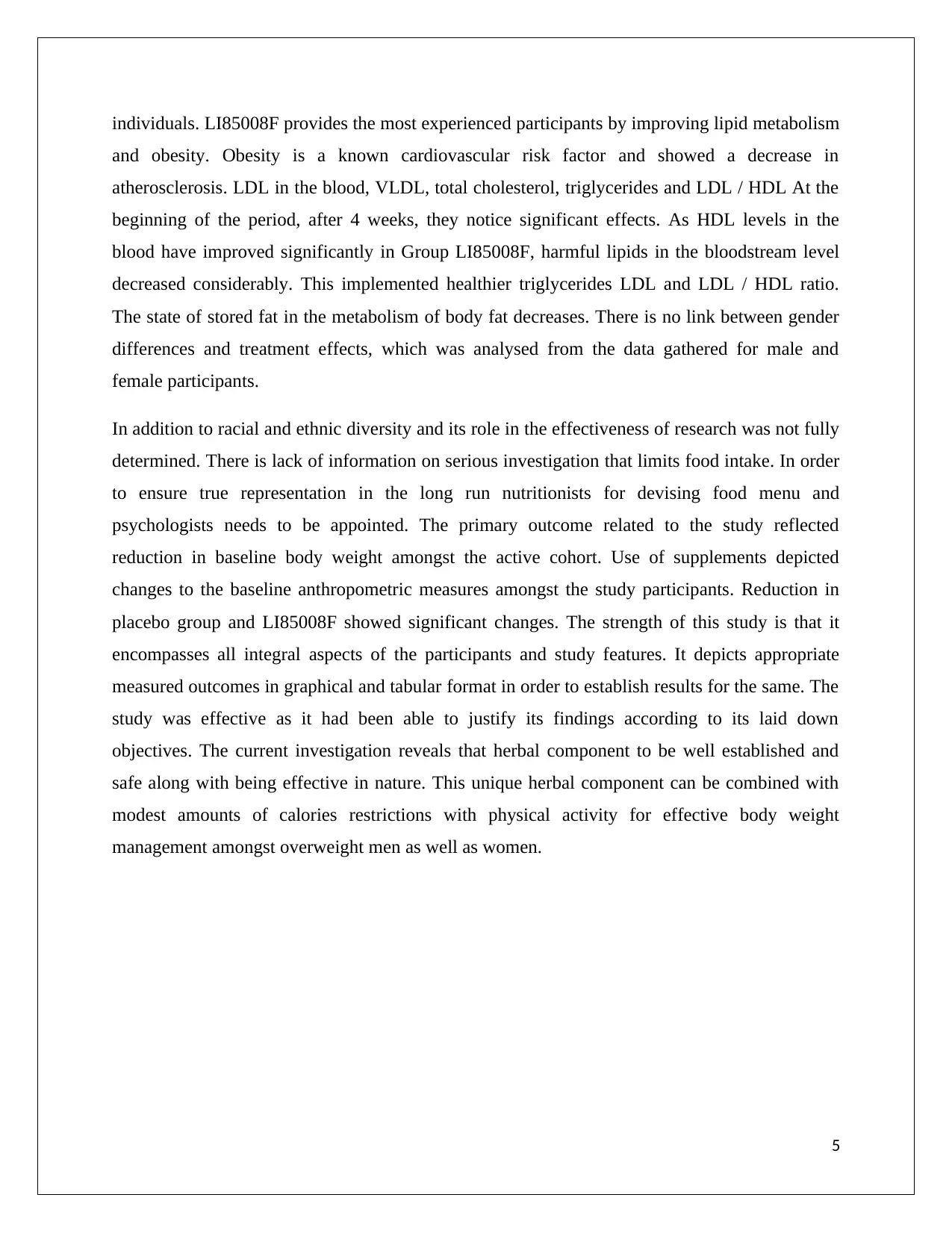
individuals. LI85008F provides the most experienced participants by improving lipid metabolism
and obesity. Obesity is a known cardiovascular risk factor and showed a decrease in
atherosclerosis. LDL in the blood, VLDL, total cholesterol, triglycerides and LDL / HDL At the
beginning of the period, after 4 weeks, they notice significant effects. As HDL levels in the
blood have improved significantly in Group LI85008F, harmful lipids in the bloodstream level
decreased considerably. This implemented healthier triglycerides LDL and LDL / HDL ratio.
The state of stored fat in the metabolism of body fat decreases. There is no link between gender
differences and treatment effects, which was analysed from the data gathered for male and
female participants.
In addition to racial and ethnic diversity and its role in the effectiveness of research was not fully
determined. There is lack of information on serious investigation that limits food intake. In order
to ensure true representation in the long run nutritionists for devising food menu and
psychologists needs to be appointed. The primary outcome related to the study reflected
reduction in baseline body weight amongst the active cohort. Use of supplements depicted
changes to the baseline anthropometric measures amongst the study participants. Reduction in
placebo group and LI85008F showed significant changes. The strength of this study is that it
encompasses all integral aspects of the participants and study features. It depicts appropriate
measured outcomes in graphical and tabular format in order to establish results for the same. The
study was effective as it had been able to justify its findings according to its laid down
objectives. The current investigation reveals that herbal component to be well established and
safe along with being effective in nature. This unique herbal component can be combined with
modest amounts of calories restrictions with physical activity for effective body weight
management amongst overweight men as well as women.
5
and obesity. Obesity is a known cardiovascular risk factor and showed a decrease in
atherosclerosis. LDL in the blood, VLDL, total cholesterol, triglycerides and LDL / HDL At the
beginning of the period, after 4 weeks, they notice significant effects. As HDL levels in the
blood have improved significantly in Group LI85008F, harmful lipids in the bloodstream level
decreased considerably. This implemented healthier triglycerides LDL and LDL / HDL ratio.
The state of stored fat in the metabolism of body fat decreases. There is no link between gender
differences and treatment effects, which was analysed from the data gathered for male and
female participants.
In addition to racial and ethnic diversity and its role in the effectiveness of research was not fully
determined. There is lack of information on serious investigation that limits food intake. In order
to ensure true representation in the long run nutritionists for devising food menu and
psychologists needs to be appointed. The primary outcome related to the study reflected
reduction in baseline body weight amongst the active cohort. Use of supplements depicted
changes to the baseline anthropometric measures amongst the study participants. Reduction in
placebo group and LI85008F showed significant changes. The strength of this study is that it
encompasses all integral aspects of the participants and study features. It depicts appropriate
measured outcomes in graphical and tabular format in order to establish results for the same. The
study was effective as it had been able to justify its findings according to its laid down
objectives. The current investigation reveals that herbal component to be well established and
safe along with being effective in nature. This unique herbal component can be combined with
modest amounts of calories restrictions with physical activity for effective body weight
management amongst overweight men as well as women.
5
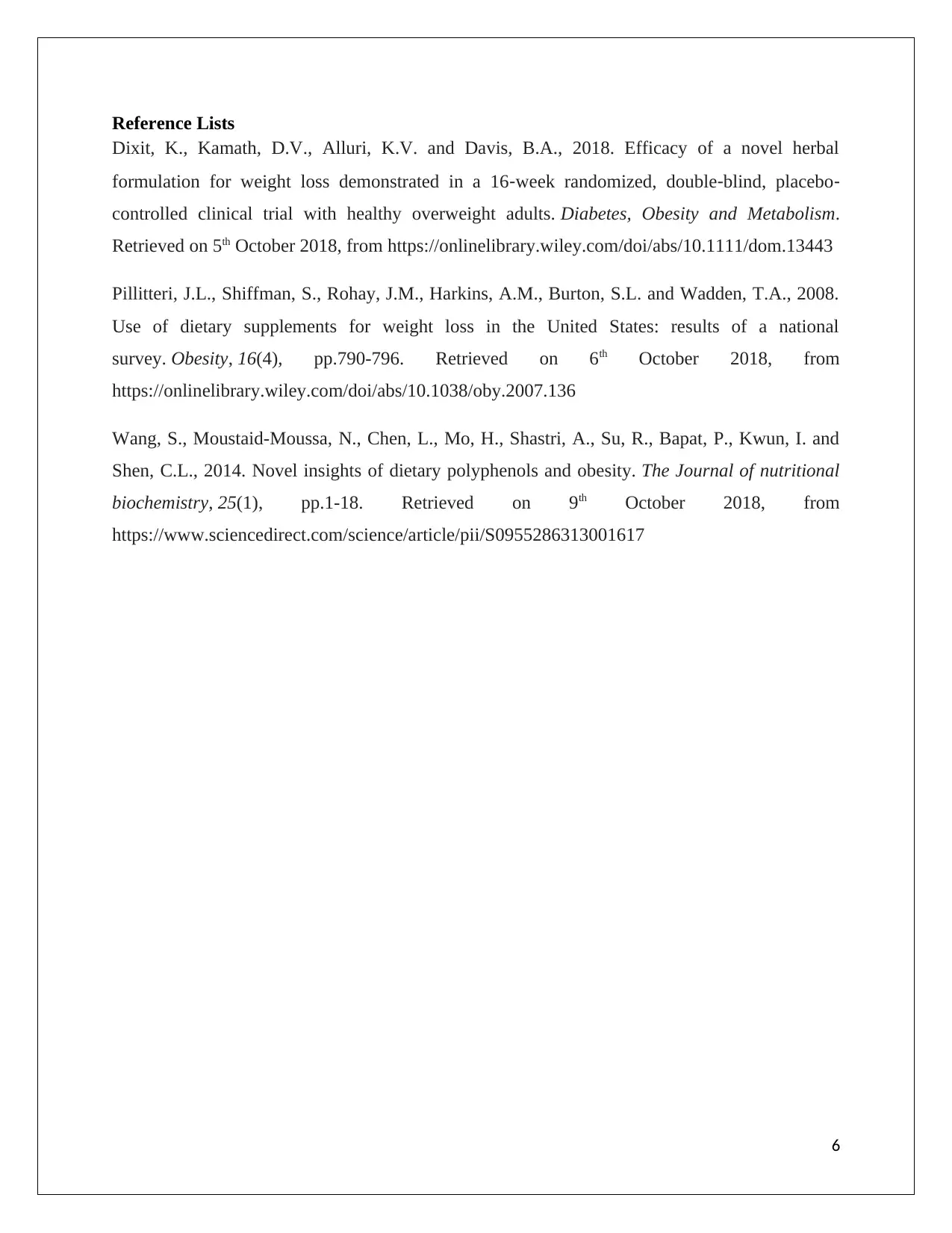
Reference Lists
Dixit, K., Kamath, D.V., Alluri, K.V. and Davis, B.A., 2018. Efficacy of a novel herbal
formulation for weight loss demonstrated in a 16‐week randomized, double‐blind, placebo‐
controlled clinical trial with healthy overweight adults. Diabetes, Obesity and Metabolism.
Retrieved on 5th October 2018, from https://onlinelibrary.wiley.com/doi/abs/10.1111/dom.13443
Pillitteri, J.L., Shiffman, S., Rohay, J.M., Harkins, A.M., Burton, S.L. and Wadden, T.A., 2008.
Use of dietary supplements for weight loss in the United States: results of a national
survey. Obesity, 16(4), pp.790-796. Retrieved on 6th October 2018, from
https://onlinelibrary.wiley.com/doi/abs/10.1038/oby.2007.136
Wang, S., Moustaid-Moussa, N., Chen, L., Mo, H., Shastri, A., Su, R., Bapat, P., Kwun, I. and
Shen, C.L., 2014. Novel insights of dietary polyphenols and obesity. The Journal of nutritional
biochemistry, 25(1), pp.1-18. Retrieved on 9th October 2018, from
https://www.sciencedirect.com/science/article/pii/S0955286313001617
6
Dixit, K., Kamath, D.V., Alluri, K.V. and Davis, B.A., 2018. Efficacy of a novel herbal
formulation for weight loss demonstrated in a 16‐week randomized, double‐blind, placebo‐
controlled clinical trial with healthy overweight adults. Diabetes, Obesity and Metabolism.
Retrieved on 5th October 2018, from https://onlinelibrary.wiley.com/doi/abs/10.1111/dom.13443
Pillitteri, J.L., Shiffman, S., Rohay, J.M., Harkins, A.M., Burton, S.L. and Wadden, T.A., 2008.
Use of dietary supplements for weight loss in the United States: results of a national
survey. Obesity, 16(4), pp.790-796. Retrieved on 6th October 2018, from
https://onlinelibrary.wiley.com/doi/abs/10.1038/oby.2007.136
Wang, S., Moustaid-Moussa, N., Chen, L., Mo, H., Shastri, A., Su, R., Bapat, P., Kwun, I. and
Shen, C.L., 2014. Novel insights of dietary polyphenols and obesity. The Journal of nutritional
biochemistry, 25(1), pp.1-18. Retrieved on 9th October 2018, from
https://www.sciencedirect.com/science/article/pii/S0955286313001617
6
⊘ This is a preview!⊘
Do you want full access?
Subscribe today to unlock all pages.

Trusted by 1+ million students worldwide
1 out of 6
Your All-in-One AI-Powered Toolkit for Academic Success.
+13062052269
info@desklib.com
Available 24*7 on WhatsApp / Email
![[object Object]](/_next/static/media/star-bottom.7253800d.svg)
Unlock your academic potential
Copyright © 2020–2025 A2Z Services. All Rights Reserved. Developed and managed by ZUCOL.

